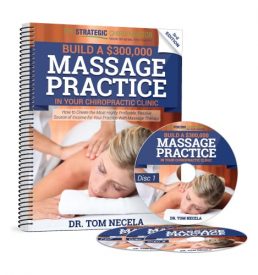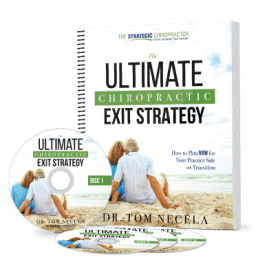In today’s post, we’re going to discuss five different financing options to buy a chiropractic practice because most chiropractors don’t seem to know where to get the money to invest when it comes time in their career to purchase an existing business.
So whether you’re seeking to buy a private practice and become a business owner for the first time, looking to expand your current office by acquiring another, or desiring to buy out the owner that you’ve been working for as an associate doctor, these are options every chiropractic buyer should know!
Even more importantly, many sellers are not aware of these options because 10, 20 or 30 years ago, when they were looking to purchase their practice, these choices either were not available — or the terms and criteria were extremely different than they are today.
So if you’ve been told that there is “no money available” or have not been shown several financing options to buy a chiropractic practice (beyond your rich uncle or owner financing), then this post is definitely for you! (And you might share it with the Seller of the practice you are interested in as well).
RECOMMENDED FINANCING OPTIONS TO BUY A CHIROPRACTIC PRACTICE
Let’s dive in and explore four good options to buy a chiropractic practice – and few that you may have to consider only with a healthy dose of caution.
- Small Business Administration (SBA) loans
SBA loans are the most common route that chiropractors choose to find funding to purchase a practice. It’s easy to see why – the SBA offers low rates, long loan terms, the lowest downpayment requirements and they typically require the least collateral of any of the lending choices.
Technically, the SBA does not actually lend you the money to purchase a chiropractic practice, a bank or other lender does. But the SBA acts as “insurance” for the bank. This is helpful for both the bank and you, the Buyer. From one angle, the SBA is another set of eyes looking upon and approving the transaction. That’s a benefit to you as the Buyer because the SBA (and ultimately) the bank will not approve a bad purchase. They don’t want to lend you the money and watch your default on your loan because the business was overpriced or a bad deal.
The SBA is a fairly fixed process in terms of the requirements so it does not vary widely from bank to bank, making it pretty predictable when it comes to your chances of getting a loan. The two downsides to the SBA backed lending as a financing option to buy a chiropractic practice is that the SBA usually has a lengthy application process and can be slower than other lending options. That said, with the excellent terms SBA lending offers, it is still the most popular choice and often “worth the wait!”
Click here to see our previous article for more info on Buying a Chiropractic Practice With an SBA Loan.
- Commercial (Conventional) Bank Loans
Commercial Bank loans are essentially non-SBA backed options where a local bank lends you money for a business or commercial purpose (as opposed to a personal loan that you might get to borrow money to borrow a car, do home improvements, or restructure debts). Because these loans originate from and the determination is decided by a local bank, their overall predictability can vary much more than SBA loans – which have fairly fixed requirements. In some cases, commercial loans can be easier to acquire than SBA loans, especially if you have an existing relationship with a lender, good credit and a healthy downpayment. Terms and rates are competitive and typically depend on the size of the loan; sometimes they can even beat out the interest rates of SBA loans. Because the loan is literally being run through only one bank (one set of eyes), they can be faster than SBA lending.
So why aren’t commercial loans the most popular choice among chiropractors? There are a few distinct reasons but the biggest is downpayment requirements. Often these loans want to see a higher downpayment requirement than SBA loans. Also, many commercial bank loans want to lend to experienced business owners; so if you are looking to purchase your first practice or buy the practice that you are currently working as an associate doctor, you may not qualify.
Despite these stricter requirements, commercial bank loans can be a great and sometimes faster option for buyers with significant downpayments and/or experience in business.
- Business lines of credit
Business Lines of Credit (LOC) are available from traditional banks and alternative lenders and can be used for any business purpose, including buying a chiropractic practice. They function similarly to a business credit card, but typically for longer terms and with larger limits – which are usually needed when financing a practice purchase.
The chief advantages of a business line of credit are speed and flexibility. Lines of credit offer quicker turnaround times compared to traditional loans (but typically slower than a MCA – see below). And business lines of credit offer great flexibility because they allow you to draw and repay from the credit line whenever needed while giving you the advantage of paying interest only on the amount borrowed (in other words, you do not need to even use the “full” or maximum line of credit offered).
The challenge to business lines of credit is that these are available only to existing business owners (after all it’s a line of credit based on your current business credit and performance). Additionally, your business must have a strong credit history.
- Merchant cash advance
A merchant cash advance (MCA) is a form of financing that is available from alternative lenders whereby the lender gives you money to use for any business purposes (including practice acquisitions) based on the current performance of your business. In this way, a MCA is a cash advance in exchange for a percentage of their daily or weekly debit and credit card sales until the advance has been repaid.
The two obvious disadvantages to MCA are that (a) you must have an existing business that can provide the lender with a performance history in order to qualify for the advance; and (b) rates may be higher than traditional forms of funding.
The big advantages to MCA are that lending requirements are more flexible and the application process is significantly streamlined. Approvals are based on the overall health of your practice, not just your credit records and financial history. In some cases, we’ve received approval in just a few business days so the MCA has the potential to be the fastest lending option of the group.
So if you are seeking fast funding and already own an existing chiropractic business, a MCA may be one of the financing options to buy a chiropractic practice that’s a good fit for you.
- Privately Funded Practice Purchase Loans
Privately funded practice purchase loans are available through private, non-bank lenders who specialize in healthcare financing. They are designed specifically for the purpose of acquiring another practice, including purchasing a retiring doctor’s practice, purchasing a partnership, or expanding your existing chiropractic practice.
On the plus side, these loans generally offer a quicker alternative to SBA or Commercial Loans – and some of these programs are as competitive as Merchant Cash Advances in terms of speed because the lenders that offer them do not have the typical bank activities that slow banks down (such as deposit accounts, other loan types, etc) and because these companies often specialize in healthcare lending (so they are very experienced with practice purchase lending). While their interest rates and terms are not typically as competitive as SBA or Commercial Loans, they often beat out MCA interest rates and sometimes Line of Credit Rates too.
The other good news about privately funded practice purchase loans is that the do not require you to be an existing business owner, so here they can beat out MCA loans and a Business LOC.
The toughest part about obtaining a privately funding practice purchase loan is the requirements to obtain the loan. An excellent credit score is needed for most lenders and collateral or a personal guarantee are required for many.
Overall, privately funded practice purchase loans can offer a “middle ground” financing option to buy a chiropractic practice and may just be the right option to suit your needs.
USE WITH CAUTION — OTHER OPTIONS TO BUY A CHIROPRACTIC PRACTICE
There are a couple additional financing options to buy a chiropractic practice that many chiropractors ask about but should all be used with caution.
A. Seller Financing – on the surface, a practice that comes with FULL owner financing sounds like a great deal; but that is not always the case. To clarify, by FULL Owner Financing, I am referring to sales where no bank needed because the Seller is willing to finance the entire amount with or without a downpayment on your part as Buyer. The theory that entices Buyers to this option is that if the Seller is willing to risk their own money by financing it, then the practice must be worth it or a good deal.
Unfortunately, there are a lot of flaws with this reasoning and a lot that can go wrong. Briefly, one of the biggest problems we see is a Seller offering Full Owner financing may also be one who is asking a price (or charging an exorbitant interest rate) that is so far above Fair Market Value that no bank would lend on its purchase. But by offering Owner Financing, the Seller can bypass the bank, appeal to a wide variety of Buyers and hopefully find one who is willing to pay much more than the practice is worth.
We don’t have time in this post to dedicate to all the dangers of FULL Owner Financing in this post, but be sure to see our article on Chiropractic Practice for Sale With Owner Financing – What Buyers & Sellers Need to Know.
Contrast that to a Seller who is offering PARTIAL Owner financing, in combination with Bank Lending. The situation is entirely different. Now you have a Seller who is confident of their practice value (because it will be appraised by the Lending bank) but who is also willing to help YOU (the Buyer) by lowering your loan amount or your downpayment amount through PARTIAL Owner Financing. We love it when our Sellers are willing to offer Partial Owner Financing and there are no “red flags” involved for you – because if the practice is not worth the price or you are totally unable to come up with any money to put towards the purchase, Partial Owner Financing won’t work. But in cases where we have a business priced a Fair Market Value, a solid Buyer who either has a little less cash than they need for a downpayment – or just wants to keep their loan balance under a certain amount – Partial Owner Financing can fill the gap and make the sale go through!
B. Investor Family or Friends – another option that many chiropractors consider is utilizing money from family or friends to make a purchase. This can be an excellent way to help you purchase or – if utilized incorrectly, it can actually make your purchase more difficult. Here, the chief challenge is HOW the money is used in the purchase and WHAT role the family or friend investor plays in your future business.
Let’s start with the bigger obstacle which is actually the role the investor will play. If you have an investor willing to give you money to help with the purchase and be a “silent” partner with no actual ownership of your practice, that is much easier. On the other hand, if the investor wishes to become a part-owner, now you’ve got a bigger hoop to jump through for several reasons.
First, if your investor is not a chiropractor, you need to know that there are many states that “prohibit” a non-chiropractor to own a chiropractic practice (see separate article here). I use quotes around the word prohibit because technically if you throw enough money and attorneys at the problem, you can find a solution (although that sometimes creates another problem if you are short on cash in the first place).
Even if you circumvent the non-DC ownership issue, you may have another problem on your hands if your investor is interested in becoming part-owner. This is because acquiring a loan with a partnership will require both of you to submit a financing application (which may not be what your investor anticipated).
Here’s the good news. The simplest solution is to have a family or friend gift you the money that you need to put towards your purchase. They will have to sign a “Gift Affadavit” for the bank stating that these funds are a gift and not a loan (although if you choose to repay your gift, that’s your decision). But as long as the bank has it on record that the source of the funds comes as a gift AND that the giver is a “silent” partner/investor (and not looking to become an actual owner), now you can easily use those funds towards a purchase.
NEXT STEPS
I am certain that there are other creative solutions that can be used as financing options to buy a chiropractic practice, but these are the most popular and ones we see most often.
It’s also quite possible that you can apply a creative twist on any of the above ideas to make them better (or worse).
Hopefully this article has given you some of the basics on what you need to know about financing options to buy a chiropractic practice – but for a “deeper dive” on the topic, you may want to check out our resources below.
Need to Learn More about Buying a Chiropractic Practice (& Loan Options)? Consider our FREE ON-DEMAND webinars and videos designed to help you learn more about buying or financing a chiropractic practice.
Need to FIND a Practice to Buy (Or an Associate Job or Ownership Opportunity)? Our FREE Practice Match service will help you do exactly that! Just fill out the form, tell us your interests and let us find you a great fit!









